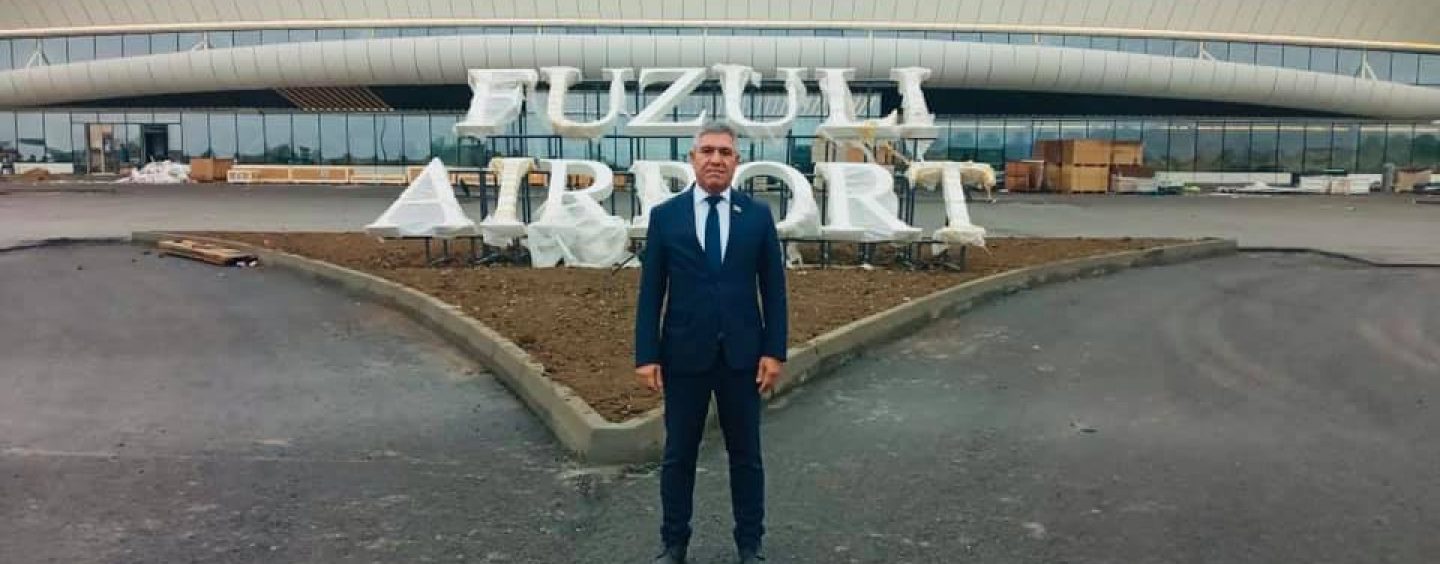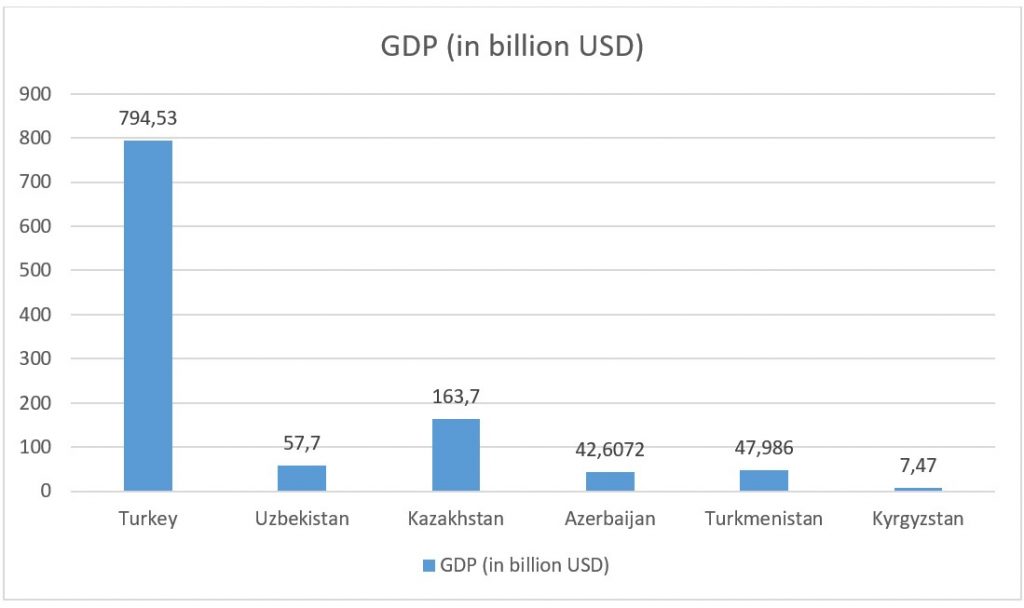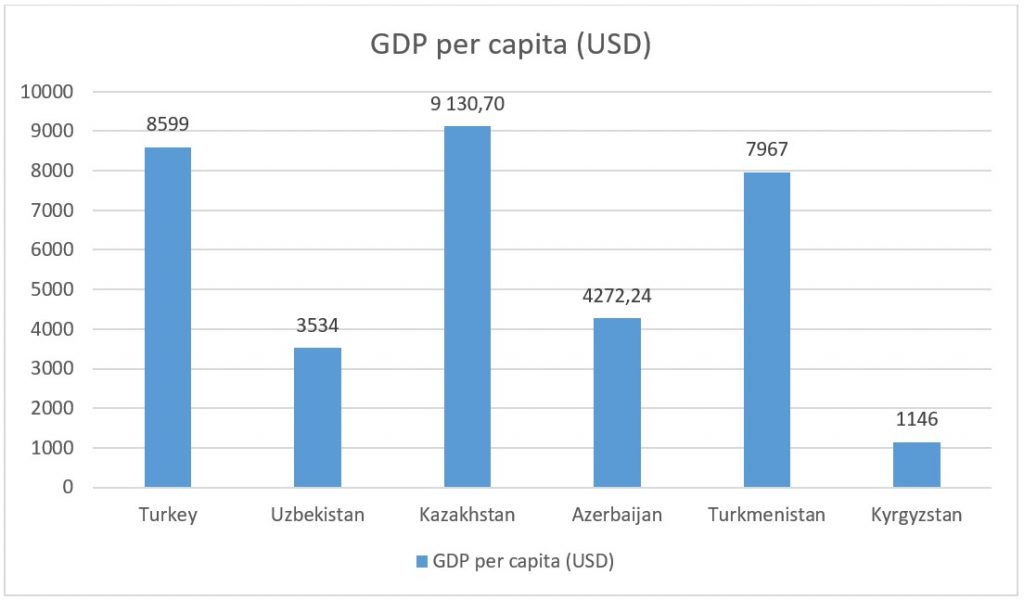
The Zangazur Corridor: New Opportunities for Integration and Cooperation in The Turkic World
By Dr. Vugar Bayramov, Member of the Parliament of Azerbaijan, Founder of CESD, Global Think Tank
Abstract
Following the signed statement, the establishment of the Zangazur corridor became even more important. Zangazur Corridor will connect the Republic of Azerbaijan and the Nakhchivan Autonomous Republic through the Meghri district of the Republic of Armenia. During the Soviet era, the route had played a notable role in regional and international railway and highway transportation among Azerbaijan, Armenia, Iran, Turkey, and Russia. Though, the conflict between Armenia and Azerbaijan caused a discontinuity in transportation for thirty years. Then the transportation relations will expand from Chine to Europe. The Zangazur Corridor will be closely involved in the formation of East-West and North-South transport links. The railways and highways will be restored in the future for the use of many countries. Thus, the corridor will cause job creation, spatial transformation, information technology, economic diversification, and growth in both direct and indirect ways.
This corridor will be the main corridor of the post-conflict period. It will be one of the leading projects for the progress of the Central Asia region and the Turkic World too. It is
expected that it will support the realization of the One Belt One Road initiative as
regional. It will also boost financial and economic relations and diversified connectivity in the region.
Key words: Zangazur Corridor, Turkic World, Central Asia, Azerbaijan, Nakhchivan
Introduction
On November 10, 2020, the President of Azerbaijan, the President of the Russian Federation, and the Prime Minister of Armenia signed a declaration to end the Nagorno Karabakh conflict and ceasefire in the region. This is a statement that ended the Second Karabakh War, which began on September 27, 2020, and lasted for 44 days, resulting in the restoration of Azerbaijan’s territorial integrity. The Republic of Armenia guarantees the security of transport links between the western regions of the Republic of Azerbaijan and the Nakhchivan Autonomous Republic in order to organize the unimpeded movement of citizens, vehicles, and cargo in both directions. Based on the agreement of the parties, the construction of new transport communications connecting the Nakhchivan Autonomous Republic and the western regions of Azerbaijan will be provided. In the meantime, Azerbaijan only had an air connection with Nakhchivan before.
This corridor is an extremely important element in terms of cooperation and transport links. This serves the interests of all countries in the region, including Armenia. In short, the opening of this corridor will add a new “artery” to the Eurasian transport network. As an example of the positive impact on trade and economic relations between the countries of the region, Turkey will have direct access to Azerbaijan, one of its main economic partners. On the other hand, the Zangazur corridor will serve as a gateway for Turkey to Central Asia, which will allow Ankara to strengthen economic ties with the Turkic world. In addition, Turkey is currently working on the Kars-Nakhchivan railway project. If the project is implemented, Nakhchivan and Turkey will unite. At the next stage, the connection of this railway with the western regions of Azerbaijan through the Zangazur corridor will give a new impetus to the development of bilateral trade relations between Baku and Ankara.
The commissioning of the Zangazur corridor will open new opportunities for the Turkic world, especially the countries of the region. The commissioning of the corridor will expand the regional transport network and stimulate economic ties between the countries of the region. In addition, it will further strengthen the region’s position in international corridors such as North-South and Central Corridor. The expansion of economic ties with the launch of the Zangazur corridor will not only bring economic benefits but also contribute to the security of the region and the establishment of peace in the region.
Literature review and Methodology
For certain economic purposes, economic corridors are united infrastructure and connect geographical or regional areas. Corridors offer vital linkages between economic nodes or hubs. They have some characteristics like regional integration and network connection. Regional integration leads directly the economic development through energy, trade, tourism, etc. Network connection fills the disparity in the economies, increases the trade flow, reduces poverty and unemployment. Transport and economic activity should not be considered in isolation. Transport and energy infrastructure involves investment in the area where there is a back demand to evolve projects (ADB, 2014).
Corridors connect the demand and supply sides of the markets. They should not be considered only people and goods transport. They should be considered as components of larger economic networks, such as global and territorial value chains and networks of production (ADB, 2013).
Janic and Vleugel (2012) state that rail freight services are considered more ecologically friendly than vehicles in medium and more distant markets. Rail freight services, on the other hand, are less efficient in terms of competition.
The Zangazur corridor will be one of the corridors that will serve these purposes. Zamanli (2018) states that Turkey sees Nakhchivan and Zangazur as a strategic corridor connecting Anatolia and Azerbaijan.
Sinirlioghlu (2015) states that Turkish countries such as Azerbaijan, Kazakhstan, Kyrgyzstan, Turkey, Turkmenistan, and Uzbekistan are ranked 13th in the world with an area of 4.5 million square kilometers, a total population of 150 million, and a total GDP of $ 1.3 trillion.
For this paper, all primary descriptive data collected from the different statistics, academic papers on the basis of qualitative research was used. Data with transport function analyzed properly. It should be noted that these methods moved the research forward.
Figure 1. Standard Transport Demand / Supply Function

Source: The Geography of Transport Systems
Most of the transport systems depend on the demand and supply relationship. According to the classic microeconomic theory, the Law of Demand affirms that the demand of the transport services decreases when service price increases. Or this process happens inversely.
According to figure 1 above, the demand curve argues that when transportation costs are high, demand is low because consumers (either freight or people) are less inclined to utilize the service. If transportation costs are low, demand will be strong since customers will receive more services for the same price. The supply curve has an inverse relationship. If costs get high, transportation providers will be ready to provide a large number of services since big profits are expected to result. When prices are low, the number of transportation services is low because many suppliers see less value from operating at a loss.
The equilibrium point is a trade-off between what users are ready to pay and what suppliers are prepared to give. Under such conditions, a certain quantity of traffic T1 would flow for a cost of operation C1. If an upgrade allows for more service at the same cost (the supply curve shifts from S1 to S2), a new equilibrium will be achieved with a quantity of traffic T2 at a price C2. Elasticity refers to the fluctuation in demand that occurs as a result of price changes. The greater it is, the more cost differences impact traffic in a transportation system.
Impacts of the corridor to Turkic World
The Turkic World has many common goals and plans, including energy, economy, trade, investment, and culture. Years ago, there was talk of building corridors in the region where mutual benefits would be achieved, the investment would be attractive and regional integration would be strengthened.
According to the Kyrgyz side, tourism and sports are the main impetus for the country’s development. They are the basis of the development of transportation, new routes, and roads. That is why the creation of a transport corridor for landlocked countries will open a bridge from China to Central Asia and further to the West.
As noted by the Kazakh side, this creates both geographical and energy links between East and West. Kazakhstan has taken this step with the New Silk Road Project[1] and the Nurly Zhol National Program[2].
The Trans-Caspian International Transport Route[3] is an example of such a relation route, which has been operating since February 2017, connects Southeast Asia and China, runs through Kazakhstan, the Caspian Sea, Azerbaijan, Georgia, and further to European countries. Earlier, there were 500 trips a year between Baku and Aktau ports. Through this corridor, it has reached 8,000 trucks, an increase of 1,300% since 2016. In general, the cargo sent from the port of Baku to the ports of Aktau and Turkmenbashi increased by 23,000 TIR trucks. The benefits of the new corridor cannot be ruled out. One of the achievements in energy transport was the establishment of new tariffs between Azerbaijan and Georgia. These new tariffs covered the transportation of goods from Turkmenistan through the Azerbaijani oil port and then by rail in Azerbaijan and Georgia. In 2019, 271,000 tons of oil were transported from Turkmenbashi port to Dubendi port by tanker, and 90,000 tons by oil ferry to Alat port.[4] As an example of the reduction in the cost of cargo transportation through the Caspian Sea, one-way cargo transportation on the Kyruk-Alat route of the Azerbaijan Caspian Shipping Company fell from $ 1,200 to $ 900, and two-way transportation from the port of Alat fell from $ 2,100 to $ 1,800.[5]
The calculation of the route of freight transport from the territory of Azerbaijan, both by sea and by land, is clearly indicated in the calculator section.[6]
In general, the Zangazur Corridor is an invaluable corridor for other Turkish World countries to benefit from the projects and programs listed. It will support economic growth by connecting the countries of the Turkic World, which currently have a nominal GDP of $ 1.1 trillion[7], and will lead to sustainable development traffic in the region.
Country cases
Turkey
Turkey, the most populous country in the Turkic world, has a population of 84,339,067[8] people. It is straddling Western Asia and Southeast Europe. The GDP of the country is USD 794.530 billion and the GDP per capita is USD 8 599[9].
The revenue of the state is $147 billion and expenditure is $171 billion. In 2019, the country carried out 135 485 million vehicle-km, 267 579 tonne-km in freight transportation.
Uzbekistan
The population of Uzbekistan is 33,469,203 people and it is a landlocked country in Central Asia. GDP USD 57.7 billion and GDP per capita is USD 3534[10]. The revenue of the state budget is USD 0,012 trillion and expenditure is USD 0.013 trillion. In 2020, the freight turnover of the country reached 1 378,8 million tons-km and rail freight turnover amounted to 23 996.1 million tons-km. In 2020, the volume of freight turnover by all types of transport, compared to 2019, decreased by 3 485.1 million ton-km. The reason is pipeline transport, the turnover of which decreased by 4 318.5 million t-km.
Kazakhstan
The recent oil price shock brought about the economic slowdown in the oil-exporting countries. One of them is Kazakhstan which is a transcontinental country mainly located in Central Asia with a smaller portion west of the Ural River in Eastern Europe and Kazakhstan showed better policy for diversification of the economy (Bayramov and Abbas, 2017).
The population of Kazakhstan is 18,776,707 people, and the GDP of the country is USD 163.70 billion. GDP per capita is USD 9,130.7[11]. Revenue in the state budget is US$278 million and expenditure is US$442 million.
According to the indicators, freight turnover of motor road transport of Kazakhstan is 185,197.3 mln. ton/km in 2018 and transportation of goods by motor road transport is 3,322.3 mln. tons in 2017. Freight turnover of all transport is 609.5 bln. ton/km in 2018.
Azerbaijan
Another Caspian basin and oil-exporting country with a 10,139,177 population is Azerbaijan. It is located at the boundary of Eastern Europe and Western Asia. Azerbaijan is among the affected countries by the oil shock. Because Azerbaijan relies highly on hydrocarbon. The instability of oil prices was experienced by a negative impact on tourism, trade, transport, etc. (Islamli, 2021). In 2019, the state made a policy- model that supports the victims suffering from oil shock – currency instability (Bayramov, 2017). The GDP of the country is USD 42.6072 billion and the GDP per capita is USD 4272,24.[12]
Revenues of the state budget of Azerbaijan amounted to USD 14,20 thousand, and expenditures – USD 15,82 thousand. The turnover of goods in the transport and non-transport sectors of the country is 93,505 million tonne-km.[13] Income from cargo transportation in the transport sector is USD 3,02 thousand.
The Baku-Tbilisi-Kars railway, which connects the railways of Azerbaijan, Georgia, and Turkey and connects Asia and Europe, is developing transport links in the region. With the help of these connections, the transport sector is developing to a new stage. In addition, the modernization of the Alat port in Baku has played a very important role in the development of the Baku-Tbilisi-Kars railway (CAREC and ADB, 2020).
Turkmenistan
Turkmenistan is a country in Central Asia, bordered by Kazakhstan to the northwest, Uzbekistan to the north, east, and northeast, Afghanistan to the southeast, Iran to the south, and southwest and the Caspian Sea to the west. After the devaluation of manat, Turkmenistan experienced almost the same situation as other Caspian Basin countries (Bayramov and Orujova, 2017). The population of Turkmenistan is 6,031,200 people. The GDP of the country is USD 47.986 billion and the GDP per capita is USD 7,967.[14] $ 22,69 billion is revenue and USD 20,58 billion. According to Humbatov and Sari (2017), Turkmenistan lacks of infrastructure and logistics, hubs and roads.
Kyrgyzstan
The population of Kyrgyzstan is 6,524,195 people and it is a landlocked country in Central Asia. Kyrgyzstan is bordered by Kazakhstan to the north, Uzbekistan to the west, Tajikistan to the south, and China to the east. The GDP of the country is USD 7.47 billion, and GDP per capita is USD 1,146. Revenue of the state budget is USD 0,70 and expenditure is USD 0,68 for 2021 first quarter. Revenues of freight by all transport is USD 0,10 million.
Figure 2. GDP of Turkic Countries

Source: State Statistics Committee of the Republic of Azerbaijan, Agency for Strategic planning and reforms of the Republic of Kazakhstan Bureau of National statistics, National Statistical Committee of the Kyrgyz Republic, State Committee of the Republic of Uzbekistan on Statistics, Turkish Statistical Institute, State Statistics Committee of the Republic of Turkmenistan
Figure 3. GDP per capita of Turkic Countries

Source: State Statistics Committee of the Republic of Azerbaijan, Agency for Strategic planning and reforms of the Republic of Kazakhstan Bureau of National statistics, National Statistical Committee of the Kyrgyz Republic, State Committee of the Republic of Uzbekistan on Statistics, Turkish Statistical Institute, State Statistics Committee of the Republic of Turkmenistan
Conclusion and Recommendation
The Zangazur Corridor, which will be established after the November 10 agreement, will contribute not only to the country and neighboring countries but also to the region. This can be seen in previous statistical studies. The corridor to be created will ensure lasting and stable peace by removing the blockade of the region. More importantly, with the help of this corridor, Asian countries will be able to easily transport goods to the West by sea and then by land.
In 2013, as a follow-up to the II International Transport and Logistics Business Forum ‘‘New Silk Road’’, Azerbaijan, Georgia and Kazakhstan signed an agreement on the establishment of a Coordination Committee for the development of the Trans-Caspian International Transport Route. The parties are the leaders of JSC “National Company” Kazakhstan Temir Zholy”, CJSC” Azerbaijan Railways “, and JSC” Georgian Railway “. The Coordinating Committee, which became the International Association in 2016, has been operating since 2017.
This applies to the results of the work of the Coordination Committee: productive complex rates for container transportation, privileged tariffs for transportation of fuel oil, gasoil, grain, and China-Kazakhstan-Azerbaijan-Georgia-Turkey container trains can participate in both rail and sea transport in a direct international rail -ferry service.
Reductions in tariff rates for this agreement do not preclude the absence of other agreements in this language in the future. For example, negotiations are underway on an agreement between Azerbaijan, Turkey, and Iran.
References
- “Zangazur Corridor Will Be of Strategic Significance for The Region”. http://www.cbc.az/az/az/news/vqar-bayramov-zngzur-dhlz-regon-n-stratej-hmyyt-malk-olacaq1617260759
- Agency for Strategic planning and reforms of the Republic of Kazakhstan Bureau of National statistics. https://stat.gov.kz/official/industry/11/statistic/8
- Bayramov, V., Abbas, G. 2017. Oil shock in the Caspian Basin: Diversification policy and subsidized economies. https://www.sciencedirect.com/science/article/abs/pii/S0301420717300326
- Bayramov, V., Orujova, L. 2017. Volatility, Diversification and Oil Shock in Resource-Rich Turkic Countries: Avenues for Recovery. http://cesd.az/new/wp-content/uploads/2017/11/Vugar_Bayramov_Laman_Orujova_Diversification_Paper.pdf
- Bayramov Vugar, Karabakh Economy: New Driver for Sustainable Economic Development in Azerbaijan, 2021, https://azerbaijantoday.az/2021/04/25/karabakh-economy-new-driver-for-sustainable-economic-development-in-azerbaijan/
- Bayramov Vugar, Dan Breban, Mukhtarov Elmir, “Economic effects estimation for the Eurasian economic union: application of regional linear regression”, Communist and Post-Communist Studies Volume 52, Issue 3, September 2019, (https://doi.org/10.1016/j.postcomstud.2019.07.001)
- Bittner, V. A., Ibrahimli, M. 2018. Baku-Tbilisi-Kars: Regional Implications and Perspectives. http://cesd.az/new/wp-content/uploads/2018/10/CESD_Research_Paper_BTK.pdf
- Brunner, H. 2013. What is Economic Corridor Development and What Can It Achieve in Asia’s Subregions? Asian Development Bank. ADB Working Paper Series on Regional Economic Integration. https://poseidon01.ssrn.com/delivery.php?ID=138112024094127010104001029025099093003082027001019058067097010018004104086010090098043103040038056011007068026007112027091001023055074034000003082116125024085106009083037117119115122104026069126070101020016001115025030074019104001074101072103127031&EXT=pdf&INDEX=TRUE
- CAREC, ADB. 2020. 2019 Carec Transport Sector Annual Report. https://www.adb.org/sites/default/files/publication/649461/carec-transport-sector-annual-report-2019.pdf
- Center for Strategic Research. 2015. Fifth Summit of the Turkic Council: A Rising Actor in Regional Cooperation in Eurasia. https://www.turkkon.org/assets/pdf/yayinlar/5-zirvesinde-turk-konseyi-ingilizce-ozel-yayin-3-tr.pdf
- Countries in the world by population (2021). https://www.worldometers.info/world-population/population-by-country/
- De, P. 2014. Economic Corridors and Regional Economic Integration. Asian Development Bank. Developing Economic Corridors in South Asia, pp. 32-44. https://ris.org.in/images/RIS_images/pdf/Developing%20Economic%20Corridors%20%28webversion%29%20%2028.4.15.pdf#page=32
- GDP per capita of Turkmenistan. https://statisticstimes.com/economy/country/turkmenistan-gdp-per-capita.php
- Humbatov, M., Sari, K. 2017. Turkic Council Countries: Infrastructure, Trade, Logistics and Transportation. https://www.researchgate.net/publication/322446385_Turkic_Council_Countries_Infrastructure_Trade_Logistics_and_Transportation
- Islamli, N. 2021. Independent Assessment of the Implementation of the 2020 State Budget of Azerbaijan. http://cesd.az/new/wp-content/uploads/2021/06/%D0%A1ESD_Assessment-2020-Budget_Implementation.pdf
- Janic, M., Vleugel, J. 2012. Estimating potential reductions in externalities from rail–road substitution in Trans-European freight transport corridors. Transportation Research Part D: Transport and Environment, V.17, I. 2, pp.154-160. https://doi.org/10.1016/j.trd.2011.09.015
- Middle Corridor. https://middlecorridor.com/en/route
- Official Information Source of the Prime Minister of the Republic of Kazakhstan. 2019. Implementation of new Nurly Zhol State Program for 2020-2025 to create more than 550 thousand jobs. https://primeminister.kz/en/news/realizaciya-novoy-gosprogrammy-nu-rly-zhol-na-2020-2025-gody-pozvolit-sozdat-bolee-550-tys-rabochih-mest
- State Committee of the Republic of Uzbekistan On Statistics. Socio-Economic Situation in The Republic of Uzbekistan. https://www.stat.uz/en/?preview=1&option=com_dropfiles&format=&task=frontfile.download&catid=331&id=1546&Itemid=1000000000000
- State Statistical Committee of the Republic of Azerbaijan. https://www.stat.gov.az/news/index.php?id=4788
- State Statistical Committee of the Republic of Azerbaijan. https://www.stat.gov.az/source/transport/?lang=en
- Tariffs for cargo transportation on the Kuryk-Alat route have changed. http://www.traceca-org.org/en/news/single-news/n/tariffs_for_cargo_transportation_on_the_kuryk_alat_route_have_changed/
- Tariffs for the transportation of Turkmen oil through the territory of Azerbaijan and Georgia have been set. https://wvvw.adyexpress.az/en-uk/archives/9475
- The Coordinating Council of the Republic of Azerbaijan on Transit Freight. Route calculator. http://transit.az/az/routes
- The Geography of Transport Systems. Standard Transport Demand / Supply Function. https://transportgeography.org/contents/chapter3/provision-and-demand-of-transportation/transport-supply-demand-function/
- The New Silk Roads Are Rising. https://www.thenewsilkroadproject.com/
- Transport. 2021. https://www.turkkon.org/en/isbirligi-alanlari/transport_10
- Turkish Statistical Institute. https://data.tuik.gov.tr/Kategori/GetKategori?p=National-Accounts-113
- Zamanli, E. 2018. Nakhchivan in The Diplomacy of Azerbaijan, Russia and Turkey. Akademik Bakis Journal. https://dergipark.org.tr/en/download/article-file/472620
[1] https://www.thenewsilkroadproject.com/
[2] https://primeminister.kz/en/news/realizaciya-novoy-gosprogrammy-nu-rly-zhol-na-2020-2025-gody-pozvolit-sozdat-bolee-550-tys-rabochih-mest
[3] https://middlecorridor.com/en/route
[4] https://wvvw.adyexpress.az/en-uk/archives/9475
[5] http://www.traceca-org.org/en/news/single-news/n/tariffs_for_cargo_transportation_on_the_kuryk_alat_route_have_changed/
[6] http://transit.az/az/routes
[7] http://www.cbc.az/az/az/news/vqar-bayramov-zngzur-dhlz-regon-n-stratej-hmyyt-malk-olacaq1617260759
[8] https://www.worldometers.info/world-population/population-by-country/
[9] https://data.tuik.gov.tr/Kategori/GetKategori?p=National-Accounts-113
[10] https://www.stat.uz/en/?preview=1&option=com_dropfiles&format=&task=frontfile.download&catid=331&id=1546&Itemid=1000000000000
[11] https://stat.gov.kz/official/industry/11/statistic/8
[12] https://www.stat.gov.az/news/index.php?id=4788
[13] https://www.stat.gov.az/source/transport/?lang=en
[14] https://statisticstimes.com/economy/country/turkmenistan-gdp-per-capita.php





